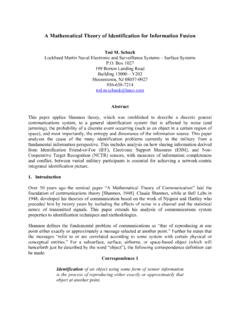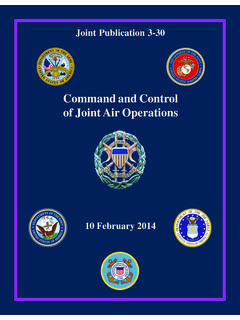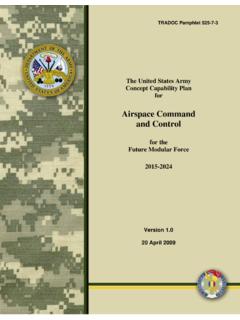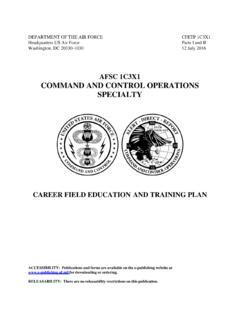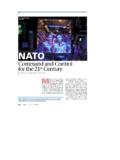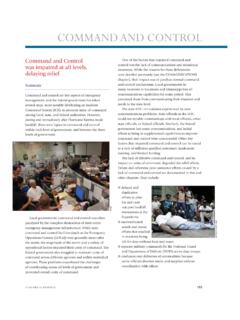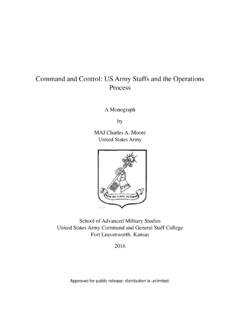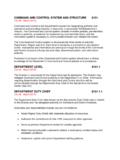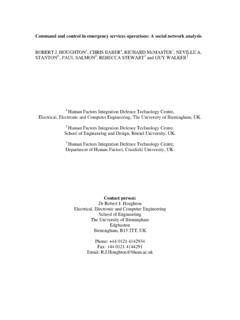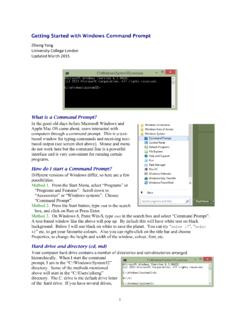Transcription of Understanding Command and Control - dodccrp.org
1 UNDERSTANDINGCOMMAND AND CONTROLD avid S. AlbertsRichard E. HayesTHE FUTURE OF Command AND CONTROLA bout the CCRPThe Command and Control Research Program (CCRP) has themission of improving DoD s Understanding of the nationalsecurity implications of the Information Age. Focusing uponimproving both the state of the art and the state of the practice ofCommand and Control , the CCRP helps DoD take fulladvantage of the opportunities afforded by emergingtechnologies. The CCRP pursues a broad program of researchand analysis in information superiority, information operations, Command and Control theory, and associated operationalconcepts that enable us to leverage shared awareness to improvethe effectiveness and efficiency of assigned missions.
2 Animportant aspect of the CCRP program is its ability to serve as abridge between the operational, technical, analytical, andeducational communities. The CCRP provides leadership for theCommand and Control research community by: articulating critical research issues; working to strengthen Command and Control research infrastructure; sponsoring a series of workshops and symposia; serving as a clearing house for Command and Control related research funding; and disseminating outreach initiatives that include the CCRP Publication is a continuation in the series of publications produced bythe Center for Advanced Concepts and Technology (ACT),which was created as a skunk works with funding provided bythe CCRP under the auspices of the Assistant Secretary ofDefense (NII).
3 This program has demonstrated the importance ofhaving a research program focused on the national securityimplications of the Information Age. It develops the theoreticalfoundations to provide DoD with information superiority andhighlights the importance of active outreach and disseminationinitiatives designed to acquaint senior military personnel andcivilians with these emerging issues. The CCRP PublicationSeries is a key element of this our Web site for the latest CCRP activities and Command and Control Research ProgramAssistant Secretary of Defense (NII)&Chief Information OfficerJohn G. GrimesPrincipal Deputy Assistant Secretary of Defense (NII)Dr.
4 Linton Wells, IISpecial Assistant to the ASD(NII)&Director of ResearchDr. David S. AlbertsOpinions, conclusions, and recommendations expressed or implied withinare solely those of the authors. They do not necessarily represent the viewsof the Department of Defense, or any other Government for public release; distribution of this publication may be quoted or reprinted without furtherpermission, with credit to the DoD Command and Control ResearchProgram, Washington, Courtesy copies of reviews would of Congress Cataloging-in-Publication DataAlberts, David S. (David Stephen), 1942- Understanding Command and Control / David S.
5 Alberts, Richard E. Hayes. p. cm. -- (Future of Command and Control ) Includes bibliographical references and index. ISBN 1-893723-17-8 1. Command and Control systems. I. Hayes, Richard E., 1942- II. Title. III. Series. Cover and illustrations by Joseph Lewis 2006 '3041--dc22 20060007712006 UNDERSTANDINGCOMMAND AND CONTROLD avid S. AlbertsRichard E. HayesTHE FUTURE OF Command AND CONTROLiTABLE OF CONTENTS1. INTRODUCTION .. 12. READER ORIENTATION .. 73. Understanding .. 114. Command AND Control .. 315. C2 CONCEPTUAL MODEL OVERVIEW .. 496. C2 APPROACHES .. 737. CONCEPTUAL MODEL: VALUE VIEW.
6 1158. CONCEPTUAL MODEL: PROCESS VIEW .. 1619. INFLUENCES .. 17910. THE WAY AHEAD .. 193 About the Authors ..207 Bibliography ..211 Index ..219 Catalog of CCRP Publications .. CAT-1iiiLIST OF FIGURESF igure 1. Minimum Essential Conceptual Elements for Room Temperature Control Model .. 19 Figure 2. Mathematical Model: Temperature Control .. 22 Figure 3. Conceptual Model with Value Metrics .. 29 Figure 4. C2 Conceptual Model .. 53 Figure 5. Outputs of Command by Domain .. 58 Figure 6. Command and Control as a Function of Domain .. 60 Figure 7. C2 Conceptual Model: C2 Approach .. 63 Figure 8. Sensemaking .. 65 Figure 9. C2 Conceptual Model: Process View .. 68 Figure 10.
7 C2 Conceptual Model: Value View .. 69 Figure 11. The C2 Approach Space .. 75 Figure 12. The C2 Problem Space .. 77 Figure 13. Three Key Dimensions of a C2 Approach .. 82 Figure 14. Comparison of a Random Network (left) and a Scale-Free Network (right) .. 105 Figure 15. Industrial Age Information Flow .. 112 Figure 16. MCP Value View .. 119 Table 1. MCPs, DOTMLP, and the Value View .. 121 Figure 17. Quality of Information Position .. 124ivFigure 18. Information Interactions .. 130 Figure 19. Information Position Componentsand Relationships .. 131 Figure 20. Individual Sensemaking .. 136 Figure 21. Collective Sensemaking .. 138 Figure 22. Reference Model: The Situation.
8 141 Figure 23. Quality of Command .. 154 Figure 24. Quality of Execution .. 157 Figure 25. C2 Conceptual Model: Process View .. 162 Figure 26. The HEAT Model .. 164 Figure 27. Network Centric Operations Conceptual Framework (top level) .. 168 Figure 28. NATO Conceptual Model for Understanding C2 .. 173 Figure 29. Collaboration: Significant Influences .. 181 Figure 30. Agility: Significant Influences .. 187 Figure 31. Synergies: Art Practice .. 195vACKNOWLEDGMENTSe would like to thank the many individuals and organi-zations who supported and assisted in the writing of thisbook. Their valuable ideas, comments, and contributionsenriched our own thoughts and of the ideas presented here were the subject of anintense 3-year international research collaboration conductedunder a charter from NATO s Research and TechnologyOrganisation (Studies, Analysis, and Simulation PanelWorking Group SAS-050),1 which produced a comprehensiveC2 Conceptual Reference Model.
9 We benefited greatly fromparticipating in that The members of SAS-050 included: Dr. David Alberts (US), Mr. Graham Cook-man (UK), Mr. Natalino Dazzi (IT), Dr. Lorraine Dodd (UK), Ms. Petra Eggen-hofer (GE), Mr. Geir Enemo (NO), Mr. Fernando Freire (PO), Dr. Anne-Marie Grisogono (Australia), Dr. Richard Hayes (US), Dr. Gary Horne (US), Dr. Reiner Huber (GE), Mr. Reinhard Hutter (GE), Mr. Gert Jensen (DK), Ms. Sarah Johnson (US), Mr. Nickolas Lambert (NL), Mr. Viggo Lemche (DK), Ms. Danielle Martin (US), Mr. Graham Mathieson (UK), Dr. Daniel Maxwell (US), Dr. James Moffat (UK), Mr. Allen Murashige (US), Mr. Klaus Niemeyer (GE), Mr. Arne Norlander (SE), Maj. Paulo Nunes (PO), Dr.
10 Paul Phister (US), Mr. Valdur Pille (CA), Mr. Dieter Rathmann (GE), Mr. Xander Roels (NL), CPT Jens Roemer (GE), Mr. Gunther Schwarz (GE), Mr. Mark Sinclair (US), Mink Spaans (NL), Ms. Kristi Sugarman (US), LTC (Ret) Klaus Titze (GE), Mr. Rick van der Kleij (NL)WviWe were also fortunate to have been able to draw upon theinsights and experiences of many colleagues. We would like tothank five individuals in particular for reviewing themanuscript for this book and providing us with thoughtful anddetailed peer reviews. These individuals are GrahamMathieson, Professor James Moffat, Dr. David Noble,Dr. David Signori, and Dr. Ed Smith.








